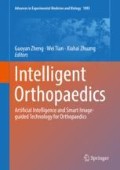Abstract
This chapter addresses the problem of segmentation of proximal femur in 3D MR images. We propose a deeply supervised 3D U-net-like fully convolutional network for segmentation of proximal femur in 3D MR images. After training, our network can directly map a whole volumetric data to its volume-wise labels. Inspired by previous work, multi-level deep supervision is designed to alleviate the potential gradient vanishing problem during training. It is also used together with partial transfer learning to boost the training efficiency when only small set of labeled training data are available. The present method was validated on 20 3D MR images of femoroacetabular impingement patients. The experimental results demonstrate the efficacy of the present method.
Access this chapter
Tax calculation will be finalised at checkout
Purchases are for personal use only
Notes
References
Laborie L, Lehmann T, Engester I et al (2011) Prevalence of radiographic findings thought to be associated with femoroacetabular impingement in a population-based cohort of 2081 healthy young adults. Radiology 260:494–502
Leunig M, Beaulé P, Ganz R (2009) The concept of femoroacetabular impingement: current status and future perspectives. Clin Orthop Relat Res 467: 616–622
Clohisy J, Knaus E, Hunt DM et al (2009) Clinical presentation of patients with symptomatic anterior hip impingement. Clin Orthop Relat Res 467: 638–644
Perdikakis E, Karachalios T, Katonis P, Karantanas A (2011) Comparison of MR-arthrography and MDCT-arthrography for detection of labral and articular cartilage hip pathology. Skeletal Radiol 40:1441–1447
Xia Y, Fripp J, Chandra S, Schwarz R, Engstrom C, Crozier S (2013) Automated bone segmentation from large field of view 3D MR images of the hip joint. Phys Med Biol 21:7375–7390
Xia Y, Chandra S, Engstrom C, Strudwick M, Crozier S, Fripp J (2014) Automatic hip cartilage segmentation from 3D MR images using arc-weighted graph searching. Phys Med Biol 59:7245–66
Gilles B, Magnenat-Thalmann N (2010) Musculoskeletal MRI segmentation using multi-resolution simplex meshes with medial representations. Med Image Anal 14:291–302
Arezoomand S, Lee WS, Rakhra K, Beaule P (2015) A 3D active model framework for segmentation of proximal femur in MR images. Int J CARS 10:55–66
Chandra S, Xia Y, Engstrom C et al (2014) Focused shape models for hip joint segmentation in 3D magnetic resonance images. Med Image Anal 18: 567–578
Krizhevsky A, ISutskever, Hinton G (2012) Imagenet classification with deep convolutional neural networks. In: Pereira F, Burges CJC, Bottou L, Weinberger KQ (eds) Advances in neural information processing systems, vol 25. Curran Associates, Inc., Red Hook, pp 1097–1105
Long J, Shelhamer E, Darrell T (2015) Fully convolutional networks for semantic segmentation. In: Proceedings of the IEEE conference on computer vision and pattern recognition (CVPR 2015), pp 3431–3440, Boston
Prasson A, Igel C, Petersen K et al (2013) Deep feature learning for knee cartilage segmentation using a triplanar convolutional neural network. In: Proceedings of the 16th international conference on medical image computing and computer assisted intervention (MICCAI 2013), vol 16(Pt 2), pp 246–53, Nagoya
Cicek O, Abdulkadir A, Lienkamp S, Brox T, Ronneberger O (2016) 3D u-net: learning dense volumetric segmentation from sparse annotation. In: Proceedings of the 16th international conference on medical image computing and computer assisted intervention (MICCAI 2016). LNCS, vol 9901, pp 424–432, Athens
Milletari F, Navab N, Ahmadi SA (2016) V-net: fully convolutional neural networks for volumetric medical image segmentation. In: Proceedings of the 2016 international conference on 3D vision (3DV). IEEE, pp 565–571, Stanford
Dou Q, Yu L, Chen H, Jin Y, Yang X, Qin J, Heng PA (2017) 3D deeply supervised network for automated segmentation of volumetric medical images. Med Image Anal 41:40–54
Ioffe S, Szegedy C (2015) Batch normalization: accelerating deep network training by reducing internal covariate shift. In: Proceedings of international conference on machine learning (ICML 2015), Lille
Yosinski J, Clune J, Bengio Y, Lipson H (2014) How transferable are features in deep neural networks? In: Advances in neural information processing systems, pp 3320–3328, Curran Associates, Inc.
Deng J, Dong W, Socher R, Li LJ, Li K, Fei-Fei L (2009) ImageNet: a large-scale hierarchical image database. In: Proceedings of the IEEE conference on computer vision and pattern recognition (CVPR 2009), Miami Beach
Simonyan K, Zisserman A (2014) Very deep convolutional networks for large-scale image recognition. arXiv:1409.1556
Szegedy C, Liu W, Jia Y et al (2015) Going deeper with convolutions. In: Proceedings of the IEEE conference on computer vision and pattern recognition (CVPR 2015), Boston. IEEE, pp 1–9
Tran D, Bourdev L, Fergus R, Torresani L, Paluri M (2015) Learning spatiotemporal features with 3D convolutional networks. In: Proceedings of the IEEE international conference on computer vision (CVPR 2015), pp 4489–4497, Boston
Karasawa K, Oda M, Kitasakab T et al (2017) Multi-atlas pancreas segmentation: atlas selection based on vessel structure. Med Image Anal 39:18–28
Acknowledgements
This chapter was modified from the paper published by our group in the MICCAI 2017 Workshop on Machine Learning in Medical Imaging (Zeng and Zheng, MLMI@MICCAI 2017: 274-282). The related contents were reused with the permission. This study was partially supported by the Swiss National Science Foundation via project 205321_163224/1.
Author information
Authors and Affiliations
Corresponding author
Editor information
Editors and Affiliations
Rights and permissions
Copyright information
© 2018 Springer Nature Singapore Pte Ltd.
About this chapter
Cite this chapter
Zeng, G., Zheng, G. (2018). Deep Learning-Based Automatic Segmentation of the Proximal Femur from MR Images. In: Zheng, G., Tian, W., Zhuang, X. (eds) Intelligent Orthopaedics. Advances in Experimental Medicine and Biology, vol 1093. Springer, Singapore. https://doi.org/10.1007/978-981-13-1396-7_6
Download citation
DOI: https://doi.org/10.1007/978-981-13-1396-7_6
Published:
Publisher Name: Springer, Singapore
Print ISBN: 978-981-13-1395-0
Online ISBN: 978-981-13-1396-7
eBook Packages: Biomedical and Life SciencesBiomedical and Life Sciences (R0)

